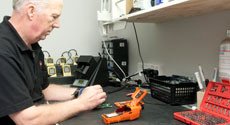
The purpose of installing a fixed-point gas detection system is to detect the presence of harmful or potentially harmful gases in the environment before they reach a dangerous level – either through toxicity or flammability.
Therefore, logic dictates the sensors for a gas detection system should be strategically placed around the potential source of any gas leakage. The closer to the source, the earlier the detection!
The closer to the source, the earlier the detection!
However, there is no one-size-fits-all answer here. Different gases have different weights and therefore behave differently in an environment.
Heavier than air
Gases that are heavier than air will tend to accumulate at lower heights, closer to ground level. To detect these heavier-than-air gases, sensors for a fixed-point gas detection system should be located 300mm to 500mm off the ground.
Examples of gases that are heavier than air include…
- Carbon dioxide
- Chlorine
- Hydrogen chloride
- Nitrogen dioxide
- Propane/butane (LPG)
Lighter than air
Gases that are lighter than air will accumulate at higher levels, closer to ceiling height. To detect these lighter-than-air gases, sensors for a fixed-point gas detection system should be mounted higher off the ground.
Examples of gases that are lighter than air include…
- Acetylene
- Ammonia
- Carbon monoxide
- Hydrogen
- Methane
- Natural gas
You should also consider where people are present within the working environment, and how they can evacuate an area if required.
In short, the location of sensors in a fixed-point gas detection system is a complex exercise in which specific expertise should be sought on a case-by-case basis.
Advice
If you have concerns or want reassurance about the placement of sensors in your fixed-point gas detection system, we have the required expertise to advise you. Click here to Contact Us »
New fixed-point gas detection system…
If you are looking at installing a new fixed-point gas detection system, we specialise in fixed gas detector systems. We can help you develop the specification, design the system, and quote on supply and installation. Click here to Contact Us »


